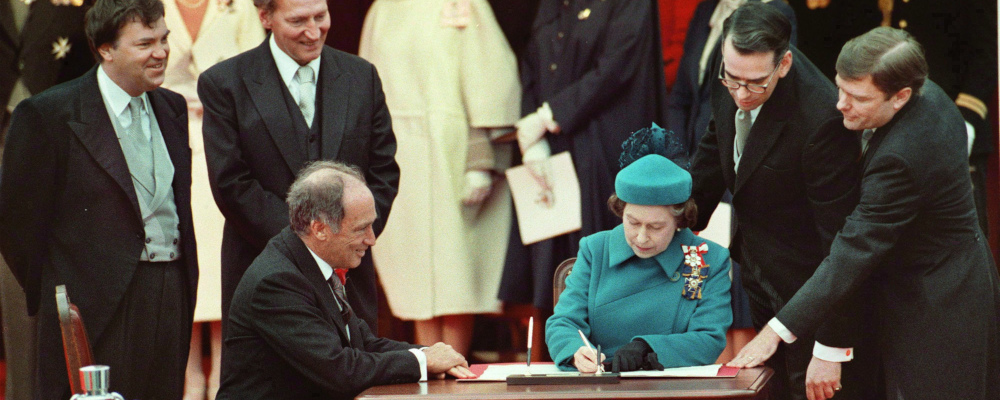2022 marks a major milestone for Canada: the 40th anniversary of the Constitution Act, 1982. This statute, which took effect on April 17, 1982, secured three major milestones for Canada.
First, it transferred full care and control over the Canadian Constitution from the United Kingdom to Canada. Second, it adopted a set of rules by which Canada could amend its Constitution. Third, it embedded a bill of rights, the Canadian Charter of Rights and Freedoms, into the Constitution. Barry Strayer, an esteemed Canadian jurist and one of the architects of the changes to our Constitution in 1982, aptly called this moment a constitutional revolution.
To mark this anniversary, I propose to make a whistle-stop journey through Canada’s constitutional history. This journey, which will finish in April to coincide with the anniversary of the Constitution Act, 1982, will have four stops: our constitutional landscape before 1982, how 1982 came about, the story after 1982, and the future of the Canadian Constitution.
The 40th anniversary of Canada’s constitutional revolution is an ideal moment to undertake what is a worthy endeavour at any time. In a society ruled by law, the portion of our law that governs all state action is of fundamental significance. The Constitution creates and sustains the basic features of Canadian society. It shapes our daily lives far more than we appreciate.
We only stand to benefit by deepening our knowledge of our Constitution. In doing so we will surely deepen our knowledge of Canada—a country that, though imperfect, merits affection and admiration. One might even say that, by learning about the law that constitutes Canada, we will grow in “true patriot love” for this remarkable country.
Part II: A Substantial Degree of Provincial Consent
As Part I of this series revealed, the goal of bringing the Canadian Constitution home, and at the same time adding to it a homegrown formula for amending the Constitution, was on the radar long before 1982. When the United Kingdom granted several members of the British Empire greater autonomy via the Statute of Westminster, 1931, a lack of consensus in Canada on what our constitutional amending formula should look like prevented this goal from being realized at that time.
Following the atrocities of World War II, a strong push at the international level for human rights protection led to the adoption of documents such as the Universal Declaration of Human Rights in 1948. This activity on the international stage generated similar momentum at the national level. It would translate, within Canada, into increased calls for adding a bill of rights to our Constitution. The constitutional “to do” list now featured three items: patriation, amending formula, bill of rights.
It would be overly simplistic to say that one person deserves the credit for bringing these constitutional aspirations to fruition. But it is also no overstatement to say that Pierre Elliott Trudeau, the 15th Prime Minister of Canada, was a driving force. Without Trudeau, 1982 would not have happened.
In 1968, Trudeau—then Minister of Justice—authored a government document entitled A Canadian Charter of Human Rights. In it, Trudeau called for adding a bill of rights to the Canadian Constitution. He also provided a de facto first draft of the Charter of Rights and Freedoms. The 1968 document offers a glimpse into Trudeau’s philosophical commitments. Decades later, in his memoirs, he wrote that he saw the Charter “as an expression of my long-held view that the subject of law must be the individual human being; the law must permit the individual to fulfil himself or herself to the utmost.”
The federal and provincial governments met on several occasions during the 1960s and 1970s to work on Canada’s constitutional “to do” list. These meetings did not bear fruit, in part because the task at hand was now more complicated. Whereas before there had been only one major obstacle in terms of securing agreement on the amending formula, now a bill of rights was also on the table.
Constitutional renewal in Canada must have seemed dead in the water when Joe Clark’s Progressive Conservatives won the federal election of May 1979. The defeated and surely dejected Trudeau not only stepped down as Liberal leader. He indicated his intention to depart from politics altogether.
But everything changed when Clark’s minority government fell in December 1979 after the House of Commons voted against his budget. Clark called an election for February 1980. The Liberals persuaded Trudeau to come back from the near politically dead and lead the party again. Trudeau would go on to win a majority government and restart the engines on constitutional reform. The next two years, which culminated in the constitutional changes of 1982, were filled with political drama and intrigue.
Trudeau’s first task after the election was the separatist threat in Quebec. The Parti Québécois government of René Lévesque had called a referendum on sovereignty-association for May 1980. Trudeau intervened, speaking against separation. Jean Chrétien, Minister of Justice and future Prime Minister, made stops across Quebec to advocate for unity. Trudeau vowed to Quebecers, in a speech four days before the vote, that he would pursue constitutional change after a separatist defeat: “We will immediately take action to renew the Constitution and we will not stop until we have done that.”
That defeat came in the form of a 60 percent vote against sovereignty-association. Trudeau honoured his promise: after a summer of meetings between government officials across the country, Trudeau and the premiers met in Ottawa in September 1980 to try and forge a deal on patriation, the amending formula, and a bill of rights that had by then come to be known as the Charter of Rights and Freedoms.
The September conference, the 10th meeting between the federal and provincial governments on the constitutional file since 1927, was likely doomed for failure before it began. The summer meetings revealed deep disagreements between the federal and provincial governments. What may have sealed the deal was when, on the eve of the conference, the premiers received a leaked copy of the federal government’s playbook for the negotiations, the contents of which did not sit well with them.
The September conference indeed led to nowhere. Perceiving the federal-provincial impasse to be permanent, Trudeau announced in October that he would, without the consent of the provinces, ask the United Kingdom to patriate the Constitution with an amending formula and a bill of rights.
Trudeau’s announcement raised important legal issues. Could the federal government unilaterally pursue fundamental changes to the Constitution? Or did the Constitution require the prior consent of the provinces to these changes? If the Constitution required prior provincial consent, how many provinces needed to be on board? Did any provinces enjoy a veto on constitutional amendment?
While Trudeau set to work on moving his proposed set of constitutional amendments through Parliament in late 1980 and early 1981, certain provinces asked the courts to rule on the legality of this federal pursuit. With the Progressive Conservatives putting up procedural obstacles in Parliament and certain provinces—the so-called Gang of Eight—creating legal and political headaches for the Prime Minister, Trudeau eventually agreed to press pause until the Supreme Court could weigh in on the legal issues raised by unilateral federal action on constitutional reform.
In September 1981, the Supreme Court ruled that the federal government would not violate constitutional law by unilaterally asking the United Kingdom to patriate the Constitution and simultaneously add an amending formula and a bill of rights to it. However, if Trudeau opted to take this path, the Court held that the federal government would breach a constitutional convention calling for a “substantial degree of provincial consent” in this context. While a breach of a constitutional convention is not enforceable by the courts, it would still violate the Constitution. As the Court pithily put it, “constitutional conventions plus constitutional law equal the total constitution of the country.”
Faced with potential political fallout and questions about the legitimacy of unilateral constitutional reform after the Court’s ruling, Trudeau convened a last-ditch meeting with the premiers in November 1981. Trudeau’s only clear allies heading into this meeting were Ontario and New Brunswick. The other provinces, that Gang of Eight, had major reservations about various aspects of Trudeau’s vision for the amending formula and the Charter. The meeting of November 1981 is impressively dissected by Ron Graham in The Last Act: Pierre Trudeau, The Gang of Eight and The Fight for Canada(2011).
If Canada’s constitutional odyssey since the 1920s could be likened to a playoff hockey game, the November 1981 conference was the overtime period. For the players and the spectators, it probably felt like triple overtime. And just when it seemed like the players would choose to stop playing rather than play to the end, there was a breakthrough.
Building on the momentum of the “Kitchen Accord” (an agreement scribbled on paper by the attorneys general of Canada, Ontario and Saskatchewan during the afternoon in a kitchenette at the conference venue), an evening of intense negotiations—with the notable absence of Quebec—secured what would become the essence of the changes made to the Constitution in 1982.
René Lévesque, the premier of Quebec, would later describe the evening of November 4th as the “Night of the Long Knives” on account of Quebec not being involved in the decisive round of negotiations. The next morning, Trudeau announced that an agreement had been reached on Canada’s constitutional future. While Quebec’s refusal to endorse the agreement precluded unanimity, the arrangement respected the “substantial degree of consensus” required by constitutional convention.
After making certain refinements to the package of constitutional reforms after the November conference, Parliament asked the United Kingdom to ratify it and thereby deliver to Canada its Constitution with a domestic amending formula and a bill of rights. The UK Parliament codified these changes by enacting the Canada Act, 1982 on March 29 of that year—precisely 115 years after the same legislature enacted the British North America Act, 1867.
Canada’s constitutional revolution would officially occur the moment Queen Elizabeth II signed the 1982 statute into law on April 17, 1982 in Ottawa with Pierre Trudeau seated next to Her Majesty.
The 40 years that have passed since that April morning have featured numerous significant constitutional moments, as Canada has learned to live with its updated Constitution. This has been especially true in terms of the impact of the Charter—some would say for better, some for worse. It is indisputable, however, that the Charter has reshaped Canadian society in fundamental ways. We will turn to this topic in Part III by exploring a selection of important Charter cases and moments since 1982.
Recommended for You

‘Industrial transformation’: Carney and Smith’s big deal for a new oil pipeline in Five Tweets

‘America’s word is no longer good’: David Frum on the Ukraine-Russia peace plan and the rise of the extremist Right in America

How Moonshot Zones could kickstart Canada’s AI-driven industrial future: Hunter Prize 2025

One Canadian economy? Not quite yet





Comments (0)